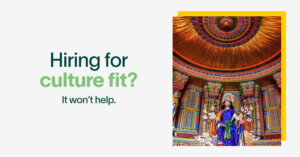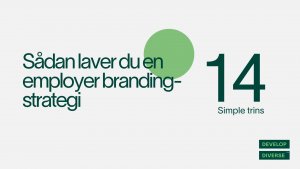Ask anyone to picture what a ‘leader’ looks like, and we’re all pretty likely to share the same mental image: A White, university-educated man, probably in a slick suit.
This mental image isn’t our fault — but it is a huge problem when it comes to building diverse and inclusive organisations. Because when we all picture the same thing, it highlights all the people who aren’t a leader. And unless we intentionally create space for leadership to become more diverse, this image is only going to become more pervasive.
But the facts don’t lie: Black women leaders experience more gendered and racialised stereotypes than White men. Many LGBTQIA+ leaders feel they can’t get to the top without a sponsor. Leaders with disabilities feel they have to hide their disability to climb the ladder.
This can harm your business profitability, growth, performance, and long-term success.
In this post, Dr Ximena Hartsock, co-founder of BuildWithin, a platform that helps companies reach and upskill apprentices ready for the workplace, explains what the problem is, and why organisations need to diversify their leadership.
4 big reasons why diverse leadership is a priority for business success
Breaking the glass ceiling around diversity in leadership is always going to be a hard-won battle.
But when organisations are able to move past the unconscious bias, stereotyping, and discrimination present in preventing others from accessing leadership roles, it opens them up to a number of benefits that impact business success and growth.
1. Homogeneous organisations are more likely to make poor decisions.
We’ve all heard the term ‘cultural fit’ in the context of hiring. And while it has recently been discredited in favour of ‘culture add’, it’s already done substantial damage in how organisations have hired in the past. Because when we don’t focus on hiring from a variety of different groups of people, we create the same type of organisation, over and over again.
“If we think about the classic example, organisations often hire people like them,” explains Dr Ximena. “They’re likely to hire graduates from the same college, who look a certain way, because they’ve made assumptions that they’re going to fit in better.”
But fitting in is bad for the business. Studies show that organisations with high levels of homogeneity are far more likely to fall into the trap of groupthink — a practice where groups of people make poor decisions as a result of consensus. This is because when we share the same worldview and background, we’re far more likely to agree on something.
2. Diverse organisations make better, more innovative products.
Due to poor decision-making and similarity of thought, homogeneous organisations are also more likely to overlook key issues with product design which exclude huge portions of the market.
“If you’re a company that builds products and you’re non-diverse, you risk creating a product that is non-inclusive for large groups of people,” Dr Ximena says. “We’ve seen this already — products are often designed without women in mind, for example, meaning they’re not the right size for women to use. It’s the same for people with low vision or who are vision impaired. They’re likely to struggle using the product due to accessibility issues.
“In the past, companies got away with this because there was less competition. But today, customers are much more educated. They’re going to find out that the ‘one-size-fits-all’ car seat isn’t designed to fit girls’ bodies as well as boys’.”
Research has consistently found that organisations with high levels of leadership diversity experience higher levels of innovation. But in the case of product design, this has a direct outcome on who can buy your product, who can access it, and who wants it, impacting your organisation’s profitability and growth.
3. Employees want to work for diverse and inclusive organisations.
Today’s workforce is becoming ever more principled about the types of companies they want to work for. Diversity and inclusion are becoming a bare minimum benchmark that dictate whether or not candidates will even apply for a role. And once they’re in, it’s a reason they’ll stay, too.
“The first thing candidates do these days is look at your company website,” Dr Ximena says. “They look at the composition of your leadership team, your advisors, your board. They look at your founders’ LinkedIn profiles, and analyse their tone of voice on social media. They notice if your C-Suite has ten men and two women. And if they don’t see diversity in your team — or support for diversity — it could make them wonder: Is your organisation checking a box by engaging with them about a role?”
4. Diversity makes your culture so much richer.
Culture and inclusion have a symbiotic relationship — one influences the other. But when both your leadership and workforce are more diverse, it can help shape a more inclusive culture — as long as your organisation is committed to honouring and valuing the ways in which people differ.
“Organisations that value inclusion and diversity experience a richer culture, because there’s greater access to different perspectives and worldviews,” Dr Ximena says. “Take our Friendsgiving event last year, for example. It became this international buffet where people felt safe bringing their experiences and culture into work and showing it through food. And that’s just a small example. Mothers returning to the workplace have a wealth of experience to bring to the table. Older people learn from younger people and vice versa. All of these experiences make your culture so much richer and bring new experiences and perspectives.
“Ultimately, when we think about diversity, it’s really about making things better for the majority,” Dr Ximena says. “Just by having diverse leadership at the top, it sets the tone for inclusion and sends a signal that this company is set up for — and working towards — a workplace that prioritises difference. Diverse leadership builds a community, not a workforce.”
___
Develop Diverse is an inclusive communication platform that helps leaders at organisations including Maersk Tankers, Vestas, and Danske Bank, make meaningful progress towards their DEI and business goals. Find out more by booking a demo with one of our team.





